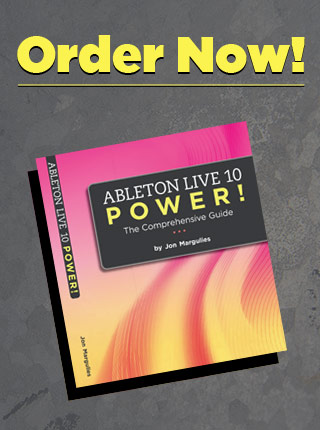Since friday night, I’ve gotten a bunch of questions about the live setup that I posted a picture of. So today I figured I’d briefly talk through it and give you a sense of how I’m using Live when I’m playing guitar. Essentially, the setup is based around using Live as an effects box and […]
ORGANIZE YOUR PRESETS, pt. 1
The only issue with saving presets as described in yesterday’s tip is that Live decides for you where the preset shows up in the browser, and if you’re like me you might want a bit more control over how things are organized. First off, be aware that right-clicking on a device allows you to use […]
ORGANIZE YOUR PRESETS, pt. 2
My personal approach to preset organization is to keep all of my presets in a folder outside the Live library. In my Mac’s “Music” folder, I keep a folder called Presets: When I want to save a preset into this folder, I skip using the Save switch entirely and use drag-and-drop instead. Just grab the […]
INSTRUMENTEMPLATE
Now that we’re all up to speed on using the External Instrument device with multi-output virtual instruments, its worth while to take a look at creating templates for these instruments. For example, here’s a set of grouped MIDI tracks that I’ve created to manage my Virus TI: Here are the External Instrument devices inserted in […]
ANALOG: 4 OSCILLATOR SYNTH
At first glance, Analog appears to be a simple two oscillator synthesizer: One important trick for getting really thick sounds out of this instrument is to take advantage of the Sub oscillators. The Sub is an extra oscillator that generates a note an octave below the main oscillator. To acess the Sub oscillator, first highlight […]
OPEN THE ENVELOPE
A lot of great synth sounds can be created with simple waveforms, filters and effects. Analog is a great synth to experiment with classic subtractive synthesis techniques. It may appear complex at first, but in a lot of ways it’s a fairly simple instrument. When Analog is loaded in its default state, you’ll hear a […]
BE SQUARE
Analog’s Shape menu offers four choices: sine, sawtooth, rectangle, and noise. Notice that I referred to the waveform highlighted above as “rectangle” rather than “square.” This is because this oscillator has adjustable pulse width. By default, the rectangle waveform is not configured to be a true square wave, instead it’s a wave that looks more […]
RANDOM OCTAVES
Another fun way to use Random is to get it to make more dramatic changes, but do it less frequently. For example, try creating some synthetic percussion with Operator (or something else, the important thing is that it not be in a Drum Rack so it responds normally to pitch). Now, program a simple part […]
THE ALTERNATOR
So, you’ve probably noticed by now that all of my suggestions for Random are tending towards the percussion side of things. The prior tip was a slight deviation, but so far I’ve been focusing in that area because getting random pitches to do things that are musically coherent opens a whole other can of worms. […]
MICROTONALIZE IT
We tend to assume that the relationship between the MIDI notes sent into a device and the sounds coming out to be relatively fixed. But in fact, depending on the instrument you’re working with, you can customize the behavior of the instrument to ignore note input completely (and always output the same note) or scale […]





